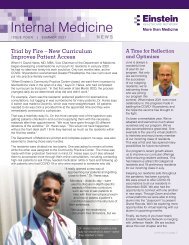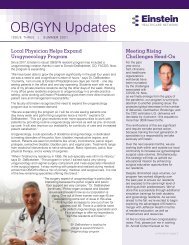Innovations in Cardiology
You also want an ePaper? Increase the reach of your titles
YUMPU automatically turns print PDFs into web optimized ePapers that Google loves.
Earlier Valve Problem<br />
McCabe first came to E<strong>in</strong>ste<strong>in</strong> through the Emergency<br />
Department, where a doctor diagnosed a problem with<br />
his heart’s tricuspid valve. In 2016, he had a procedure at<br />
E<strong>in</strong>ste<strong>in</strong> called r<strong>in</strong>g annuloplasty. This surgery tightens the<br />
heart’s tricuspid valve by putt<strong>in</strong>g a plastic or metal r<strong>in</strong>g<br />
around it.<br />
The r<strong>in</strong>g helped McCabe to breathe better and gave him<br />
more energy, but the recovery was tough, Dr. Witzke said.<br />
“He had a long hospitalization and a difficult post-surgical<br />
recovery.”<br />
When McCabe later developed mitral valve regurgitation,<br />
he didn’t want another heart surgery. The MitraClip<br />
seemed like the best option.<br />
Dr. Witzke says he and Dr. Tuluca perform these procedures<br />
together because each of them has a different<br />
expertise. “I understand ultrasound and X-rays and<br />
catheters; that’s my niche. But she sees mitral valves<br />
anatomically more than I do because she’s <strong>in</strong> the OR<br />
and knows how the anatomy should be. So I th<strong>in</strong>k our<br />
skills blend together.”<br />
Another important doctor on the team is Gregg Pressman,<br />
MD, a cardiologist who specializes <strong>in</strong> read<strong>in</strong>g the ultrasound<br />
images provided by an echocardiogram to guide<br />
heart procedures.<br />
McCabe still remembers wak<strong>in</strong>g up after the MitraClip<br />
procedure. “Dr. Tuluca was stand<strong>in</strong>g there. She got me<br />
up out of bed that afternoon, the second day. I wasn’t <strong>in</strong><br />
the mood to do that. But she made me walk all the way<br />
down to one end of the hallway and all the way back.<br />
She wanted to know what I felt like. I felt pretty good.”<br />
When he went home later that day, “I was afraid to do a<br />
lot because I wasn’t used to do<strong>in</strong>g a lot. But then I started<br />
tak<strong>in</strong>g some short walks, and then the walks got longer.”<br />
Now McCabe says he’s back to a more normal rout<strong>in</strong>e.<br />
“I feel 100% better.”<br />
by Lisa Ellis for E<strong>in</strong>ste<strong>in</strong> Perspectives<br />
Orig<strong>in</strong>ally appeared <strong>in</strong> E<strong>in</strong>ste<strong>in</strong> Healthcare Network’s<br />
Perspectives blog. To access the blog and more <strong>in</strong>formation<br />
about network services, please visit www.e<strong>in</strong>ste<strong>in</strong>.edu.<br />
Christian F. Witzke, MD<br />
Director of the Structural Heart Disease Program and<br />
Director of the Lat<strong>in</strong>-American Cardiovascular Program<br />
E<strong>in</strong>ste<strong>in</strong> Medical Center Philadelphia<br />
Dr. Witzke completed his Internal Medic<strong>in</strong>e residency and Cardiovascular<br />
Medic<strong>in</strong>e fellowship tra<strong>in</strong><strong>in</strong>g at E<strong>in</strong>ste<strong>in</strong> Medical Center.<br />
He then completed two-year tra<strong>in</strong><strong>in</strong>g <strong>in</strong> Interventional <strong>Cardiology</strong><br />
and Structural Heart Disease at the Massachusetts General<br />
Hospital (MGH), Harvard Medical School. At MGH, Dr. Witzke<br />
became competent <strong>in</strong> the performance of coronary <strong>in</strong>tervention<br />
and mastered the management of extremely ill cardiac patients<br />
that required high-risk percutaneous procedures.<br />
Dr. Witzke has a special <strong>in</strong>terest <strong>in</strong> the grow<strong>in</strong>g field of Structural<br />
Heart Disease. Dur<strong>in</strong>g his last years of tra<strong>in</strong><strong>in</strong>g, he became<br />
specialized <strong>in</strong> the management of valvular and structural heart<br />
disease. He is proficient <strong>in</strong> the art of percutaneous closure of<br />
heart defects, paravalvular leaks and management of various<br />
valvular heart diseases, <strong>in</strong>clud<strong>in</strong>g aortic stenosis and mitral<br />
valve disease and is the lead<strong>in</strong>g implanter of percutaneous aortic<br />
valve prosthesis – also known as TAVR – <strong>in</strong> patients with aortic<br />
stenosis. He also helped develop the Cardiogenic Shock Program<br />
at E<strong>in</strong>ste<strong>in</strong> Health Network. He has published <strong>in</strong> numerous<br />
journals and has participated <strong>in</strong> <strong>in</strong>ternational meet<strong>in</strong>gs as<br />
an expert <strong>in</strong> the field of Structural and Valvular Heart Disease.<br />
Areas of Interest<br />
Adult Congenital Heart Disease, Adult Structural Heart Disease,<br />
Cardiac Catheterization, Cardiovascular Diseases, Valvular<br />
Heart Disease<br />
11


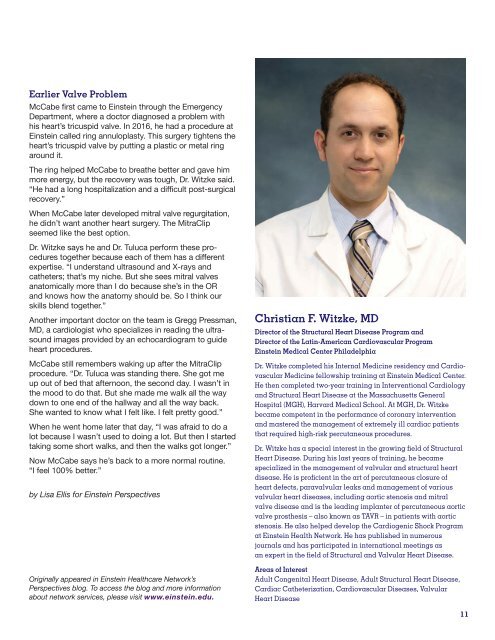
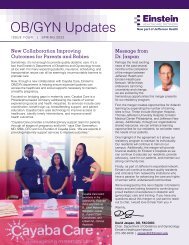
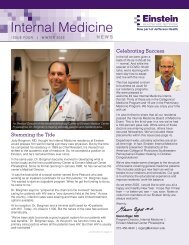
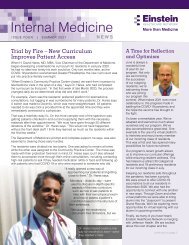
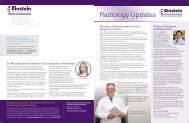


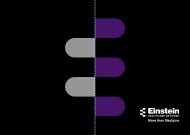
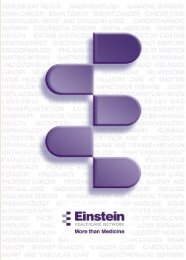
![Donor_Impact_Report_2019[1]](https://img.yumpu.com/65872065/1/186x260/donor-impact-report-20191.jpg?quality=85)



